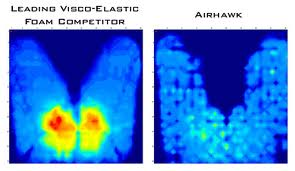
Are you familiar with the blissful comfort of a ROHO air cell cushion?
The ROHO Group, Inc., has been the leading pioneer in Shape Fitting Technology®, or DRY FLOATATION® as it's known in the medical industry, since 1973. They currently hold 220 patents in 60 countries. The technology was originally invented for wheelchair users, but is now also being used in consumer products such as seat cushions for motorcycles, office chairs, helicopters, planes, cars, trucks, and pillows.
Shape Fitting Technology from ROHO is a system of soft, flexible air cells interconnected by small channels that allows air to flow from one cell to another at a controlled rate. This is what sets ROHO Shape Fitting Technology apart from the others; the ability to protect the body from multiple forces – pressure, friction, shear, shock, and vibration – and maintain the same level of comfort and protection indefinitely.
ROHO products all have something in common - a valve that allows you to adjust the amount of air it holds. This valve lets you customize the product to your specifications and achieve your precise level of comfort. It is designed to perfectly match your shape and contour, redistributing your body weight to minimize pressure "hot spots."
In the picture bove you will see how the pressure mapping photos illustrate the difference between a conventional cushion and one using Shape Fitting Technology. Red and yellow areas on the left photo highlight uncomfortable pressure points. However the right photo shows how the ROHO cushion redistributes the pressure over the entire surface area, allowing for better blood circulation and ultimately more comfort.
This technology has proven effective for prevention and healing of ischemic ulcers, comfortable positioning & proper stability needed by wheelchair users, and added comfort to anyone who endures extended sitting times.
The inventor Robert H. Graebe chose to use air as the fluid instead of water because of the weight and potential problems water could cause. Water is affected by gravity, difficult to adjust, hard to regulate by temperature, and requires lengthy setup and takedown times.
Foams and gels don’t possess all of the same properties as air, and thus are inadequate at providing appropriate pressure distribution without tissue deformation. Foams compress with time becoming virtually useless, and gels tend to be heavy, coagulate over time. They also become softer when hot and harder when cold, due to changes in density from temperature exposure.
